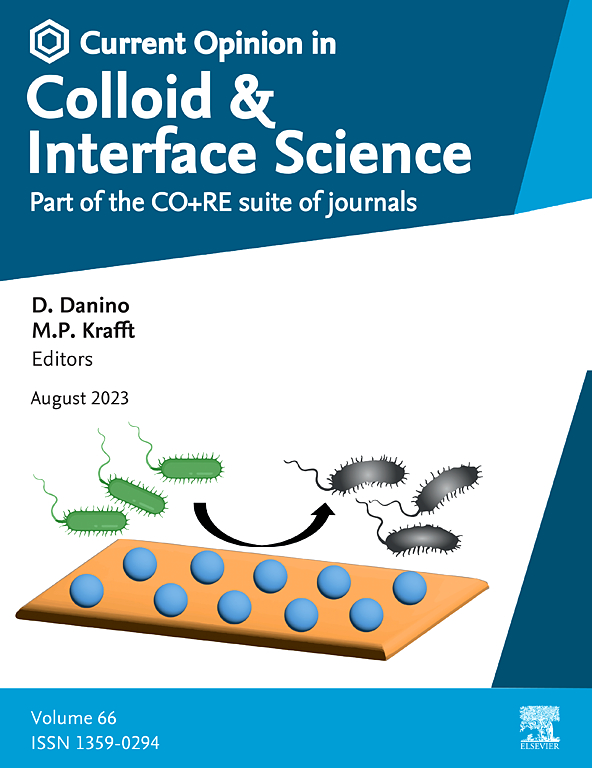Open issues in the linear and NonLinear rheology of wormlike micelles
IF 7
2区 化学
Q1 CHEMISTRY, PHYSICAL
Current Opinion in Colloid & Interface Science
Pub Date : 2025-03-28
DOI:10.1016/j.cocis.2025.101919
引用次数: 0
Abstract
We review experimental evidence and theoretical/modeling approaches on Wormlike Micelles (WLMs) dynamics in linear and nonlinear regimes. We focus on recent works regarding the extraction of quantitative microscopic information from linear rheology data and the possibility of quantifying the fast relaxation processes. Models for WLMs undergoing reptation and chain sequence rearrangement are discussed. Strong shear and elongational flows that can cause interesting phenomena, e.g. chain scission, structure formation, and elastic instabilities in WLMs, are considered. More specifically, start-up shear flow in the nonlinear regime, LAOS experiments, and relative data treatment are discussed, together with shear-banding phenomena and their dynamics, inertio-elastic instabilities, and secondary flow. Different techniques for measuring WLMs in extensional flow are compared, referring in particular to the recent dripping-onto-substrate (DoS) extensional rheometry, which is able to address some shortcomings of the CaBER technique. We finally deal with the potential source of triggering flow profiles and secondary flows with fluid properties and external conditions.

虫状胶束的线性和非线性流变学的开放性问题
本文综述了线性和非线性条件下虫状胶束动力学的实验证据和理论/建模方法。我们关注的是最近关于从线性流变数据中提取定量微观信息和量化快速松弛过程的可能性的工作。讨论了WLMs复制和链序列重排的模型。强剪切和拉长流动可以引起有趣的现象,如链断裂,结构形成和弹性不稳定的wlm,被考虑。更具体地说,讨论了非线性状态下的启动剪切流,老挝实验和相关数据处理,以及剪切带现象及其动力学,惯性-弹性不稳定性和二次流。本文比较了在拉伸流动中测量wlm的不同技术,特别提到了最近的滴入-基底(DoS)拉伸流变法,该技术能够解决CaBER技术的一些缺点。最后讨论了流体性质和外部条件下触发流动剖面和二次流动的潜在来源。
本文章由计算机程序翻译,如有差异,请以英文原文为准。
求助全文
约1分钟内获得全文
求助全文
来源期刊
CiteScore
16.50
自引率
1.10%
发文量
74
审稿时长
11.3 weeks
期刊介绍:
Current Opinion in Colloid and Interface Science (COCIS) is an international journal that focuses on the molecular and nanoscopic aspects of colloidal systems and interfaces in various scientific and technological fields. These include materials science, biologically-relevant systems, energy and environmental technologies, and industrial applications.
Unlike primary journals, COCIS primarily serves as a guide for researchers, helping them navigate through the vast landscape of recently published literature. It critically analyzes the state of the art, identifies bottlenecks and unsolved issues, and proposes future developments.
Moreover, COCIS emphasizes certain areas and papers that are considered particularly interesting and significant by the Editors and Section Editors. Its goal is to provide valuable insights and updates to the research community in these specialized areas.

 求助内容:
求助内容: 应助结果提醒方式:
应助结果提醒方式:


